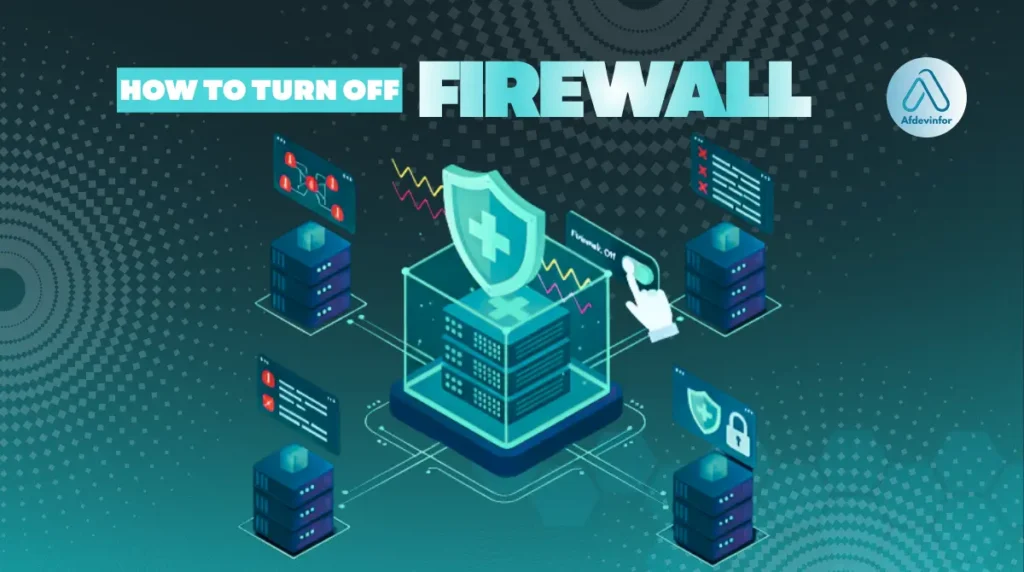When trying to figure out how do I turn firewall off, it’s usually because an essential application or game is being blocked, and frustration is setting in. I’ve been there. After over a decade of hands-on tech support, I can tell you that while it’s tempting to blame the firewall, turning it off completely should be your absolute last resort. Think of your firewall as a dedicated bouncer for your computer, meticulously checking every piece of data that tries to get in or out. This guide is my ‘safety-first’ approach to solving your problem, starting with understanding your firewall settings and exploring safer alternatives before taking the big step of disabling your digital guard.
1. Should you turn off your firewall? A quick decision guide
This is the most critical question, and my answer is almost always: probably not. Disabling your firewall, even for a few minutes, is like leaving the front door of your house wide open in a busy neighborhood. Before you proceed, it’s essential to make an informed choice rather than a reckless one. This section is designed to empower you with a clear decision-making framework.
1.1. Use this flowchart before you proceed
To help you decide, I’ve created a simple decision-making process. Ask yourself these questions in order before jumping to the instructions.
Here’s a text-based summary of the decision tree to guide you:
- Question 1: Is the application you’re trying to use from a trusted, well-known developer? (e.g., Microsoft, Adobe, a major game studio). If NO, stop immediately. Do not disable your firewall for untrusted software.
- Question 2: Are you connected to a private, trusted network like your home Wi-Fi? If NO (e.g., you’re on public Wi-Fi at a cafe or airport), do NOT turn off your firewall. The risk is too high.
- Question 3: Have you first tried the safer alternative of allowing the specific app through the firewall? If NO, proceed to Section 2 of this guide. This solves the problem in over 90% of cases without exposing your entire system.
- Final Action: If you answered YES to all three questions, you may proceed to Section 3 for instructions on temporarily disabling your firewall for troubleshooting.
1.2. What happens if I disable my firewall? (The risks)
So, what happens if I disable Windows Defender Firewall? The moment you do, your computer becomes directly exposed to the internet and your local network. Here are the most significant firewall risks you should be aware of.
| Warning The risks of disabling your firewall are serious and immediate, especially on public networks. |
Here are the primary threats you’ll face:
- Unauthorized Access: Hackers on the network can scan for open ports on your computer and may attempt to gain remote access, steal your personal files, or install spyware.
- Malware and Virus Infections: Many types of malware, particularly worms, actively scan networks for unprotected devices to infect. A disabled firewall removes this critical barrier.
- Data Theft: Malicious software can potentially transmit your sensitive data (like passwords and financial information) from your computer without your firewall there to block the unauthorized outbound connection.
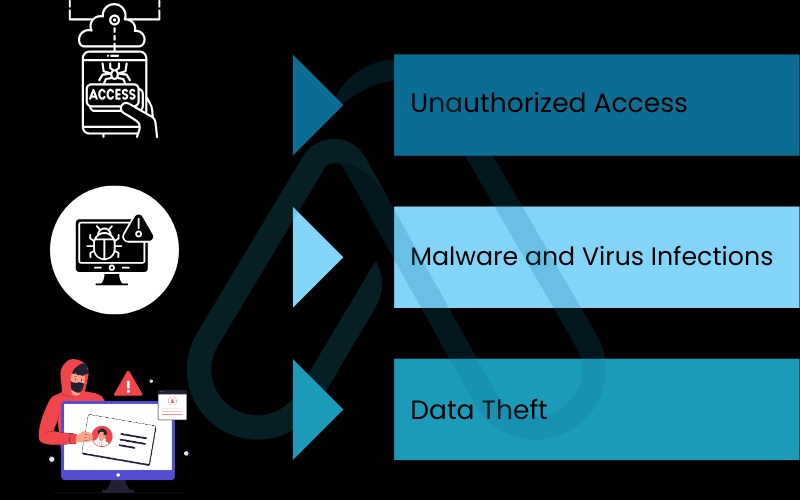
2. How to allow an app through the firewall
Before you even consider disabling your entire defense system, let’s try the smart, targeted solution. In 9 out of 10 cases I’ve handled, the problem isn’t the firewall itself, but a single rule blocking a trusted program. Here’s the right way to fix it by learning how to allow an app through the firewall.
2.1. Allowing an app on Windows 11
The process on Windows 11 is streamlined through the Windows Security app. Follow these steps carefully:
- Open Windows Security. Press the Windows key, type Windows Security, and press Enter.
- Navigate to Firewall protection. In the left-hand pane, click on Firewall & network protection.
- Access the app list. Click on the link that says Allow an app through firewall.
- Change settings to make edits. You’ll see a list of apps. Click the Change settings button at the top right. You may need administrator permission.
- Find and allow your app. Scroll through the list to find your program. If it’s not there, click Allow another app… to browse for its executable (.exe) file. Once found, check the box next to it. Critically, I advise you to only check the box under the Private column unless you absolutely need the app to work on public networks.
2.2. Allowing an app on Windows 10
The steps for Windows 10 are very similar, often starting from the classic Control Panel. Here is what you need to do:
- Open the Firewall settings. Press the Windows key, type Windows Defender Firewall, and press Enter. This will open the Control Panel applet.
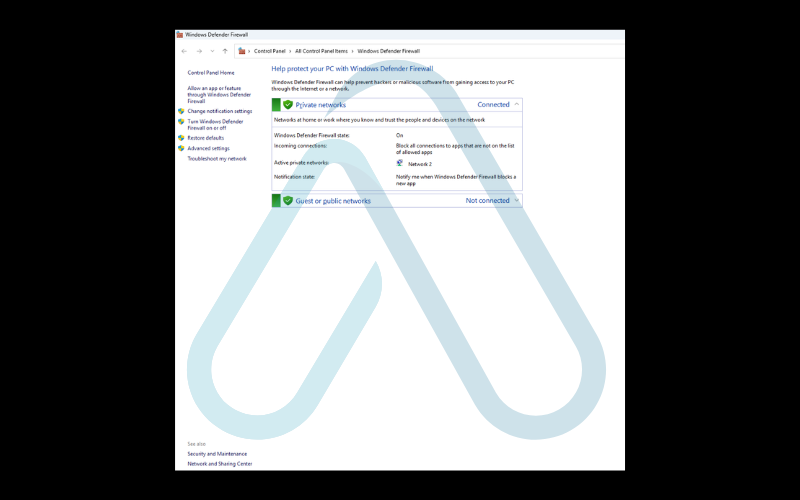
2. Find the app settings link. In the left-hand menu, click on Allow an app or feature through Windows Defender Firewall.
3. Enable changes. Just like in Windows 11, you must first click the Change settings button to unlock the list for editing.
4. Locate and permit your application. Find your app in the list or use the Allow another app… button to add it. Again, I strongly recommend you only check the Private network box for security. Click OK to save your changes.
[Annotated screenshot for each step showing the Windows 10 Control Panel interface.]
3. How to temporarily turn off your firewall (Windows)
If you’ve gone through the decision guide and tried the safer alternative with no success, this section will show you how to temporarily disable the firewall. I must stress the word ‘temporarily’. This should only be done for a specific troubleshooting purpose.
| Warning Only follow these steps if you are on a trusted private network and have a specific troubleshooting goal. Remember to turn your firewall back on immediately after you are done. |
3.1. Disabling the firewall in Windows 11
To turn off firewall Windows 11, you’ll use the Windows Security hub. It’s crucial to understand the three network profiles: Domain (for corporate networks), Private (for your trusted home network), and Public (for cafes, airports, etc.). You only need to disable the one that is currently active.
- Open Windows Security. Press the Windows key, type Windows Security, and hit Enter.
- Go to Firewall & network protection. Select this option from the left-hand menu.
- Select the active network profile. You will see the three profiles listed. The one you are currently connected to will be marked as (active). Click on it.
- Turn the firewall off. Under the ‘Microsoft Defender Firewall’ section, you will see a toggle switch. Click it to set it to Off. Windows will show a notification warning you that the firewall is off.
3.2. Disabling the firewall in Windows 10
The process to turn off firewall Windows 10 is nearly identical to Windows 11, using the same Windows Security interface. If you are on an older build of Windows 10, you might access this through the Control Panel, but the steps below are for modern versions.
1. Launch Windows Security. You can find it by searching in the Start Menu.
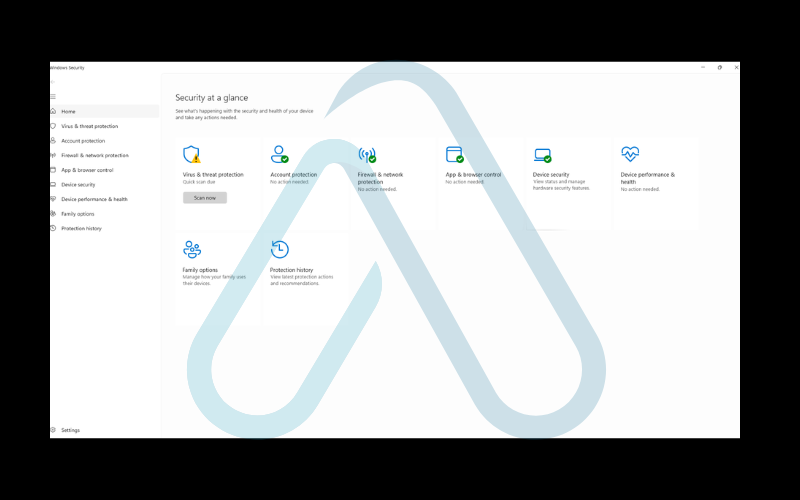
2. Click on Firewall & network protection.
3. Choose your active network. Just like in Windows 11, identify and click on the network profile marked as (active).
4. Disable the firewall. Find the ‘Microsoft Defender Firewall’ toggle and switch it to the Off position. Acknowledge any security warnings. Remember to turn this back on as soon as you’re finished testing.
[Numbered list with clear screenshots showing the Windows 10 process.]
4. Instructions for Mac and routers
For those of you in a multi-device environment, I’ve included this bonus section. Your PC isn’t the only device with a firewall; your Mac and even your internet router have one too.
4.1. How to turn off the firewall on a Mac
On macOS, the firewall is often off by default, but it’s good to know how to check and manage it. The process is straightforward.
Here’s how to turn off the firewall on a Mac:
1. Open System Settings. Click the Apple icon in the top-left corner and select System Settings (or System Preferences on older macOS versions).
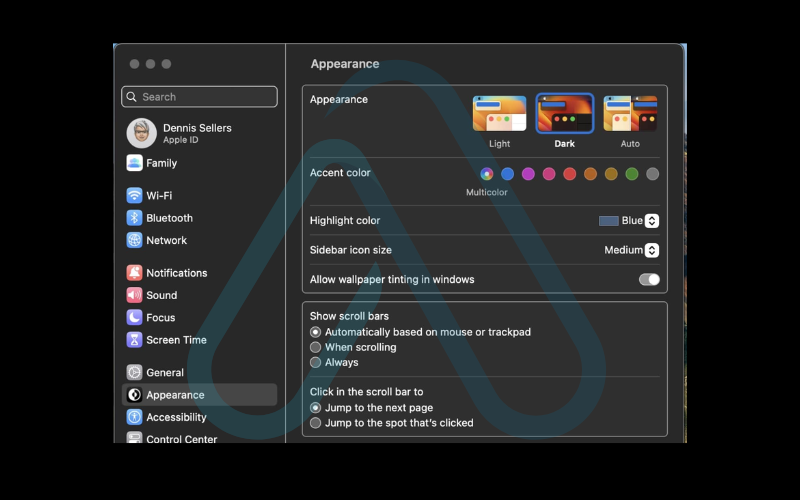
2. Go to Network. In the settings window, find and click on Network in the sidebar.
3. Select Firewall. You should see a Firewall option. Click it.
4. Toggle it off. There will be a simple toggle switch. Click it to turn the firewall off. You may be prompted to enter your administrator password.
4.2. A quick note on your router’s firewall
Your internet router is the very first line of defense for your entire home network. It has a built-in hardware firewall that blocks unsolicited incoming traffic from the internet before it ever reaches your computer. I strongly advise against disabling this. If a program (usually a game server or peer-to-peer application) requires a direct connection, the proper and secure solution is not to disable the router’s firewall but to use a feature called port forwarding or virtual server. This opens a specific ‘door’ for that one application only, leaving the rest of your network protected. Consult your router’s manual for specific instructions, as the interface varies widely between manufacturers.
5. What to do after disabling the firewall
If you’ve had to temporarily disable your firewall for a test, following this checklist is non-negotiable for your security. Your number one priority is to re-enable your protection.
Here is your essential safety checklist:
- TURN YOUR FIREWALL BACK ON. The moment your test is complete, navigate back to the firewall settings and toggle it back to ‘On’.
- Restart the Application. After re-enabling the firewall, check if the application that originally had an issue still works. If it does, your problem might have been a temporary glitch.
- Consider the Real Solution. If the app only works with the firewall off, you’ve confirmed the firewall is the blocker. Now, go back to Section 2 and add a specific exception for that app. That is the correct long-term fix.
- TURN YOUR FIREWALL BACK ON. I’m repeating this because it’s that important. Don’t forget.
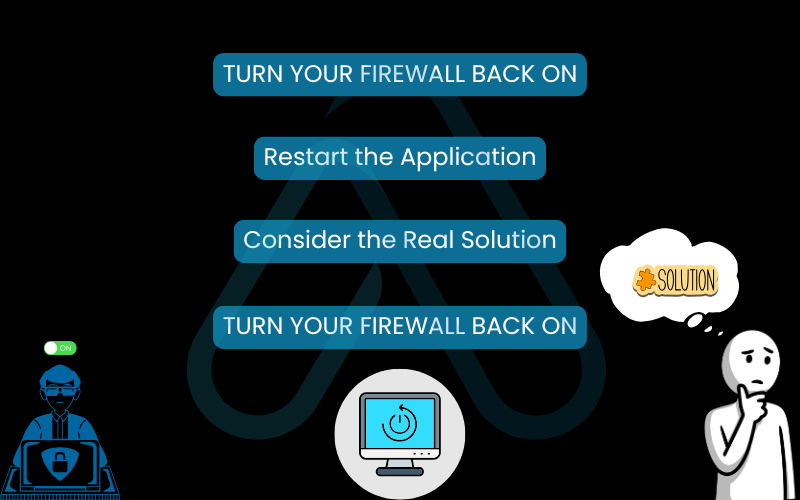
6. Firewall off, but still not working? What to check next
One of the most common frustrations I hear is, ‘I turned off the firewall, and my app still won’t connect!’ This is actually good news. It means your firewall wasn’t the problem, and you can safely turn it back on. If you’re in this boat, it’s time for some further Windows firewall troubleshooting.
Here are the next places I would check:
- Your Antivirus Software: Many third-party antivirus suites (like Norton, McAfee, or Bitdefender) come with their own powerful firewalls that override the Windows Defender Firewall. If you have one installed, you’ll need to check its settings to allow the app.
- The Application’s Own Settings: Some programs, especially communication and networking tools, have their own internal network or proxy settings that may be misconfigured.
- Your Network Connection: Is your internet connection stable? Can other devices on the network access the internet? Sometimes the simplest explanation is the right one.
- Router or ISP Issues: Your Internet Service Provider (ISP) or a setting on your router could be blocking the connection. This is common with certain gaming ports.
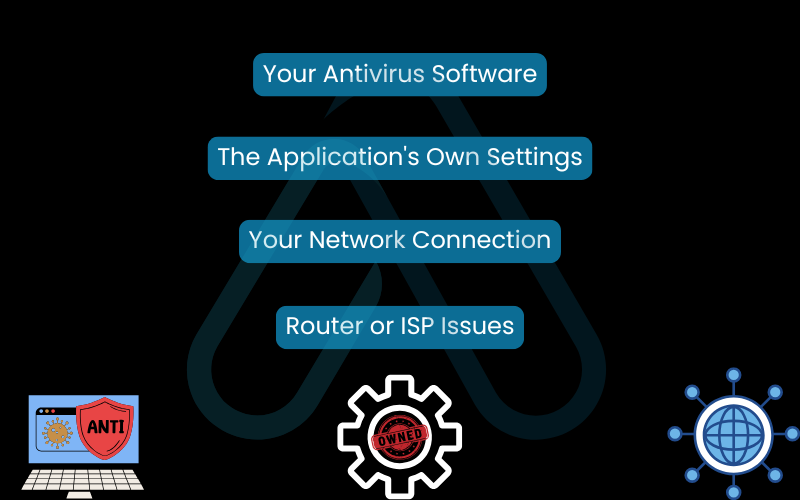
7. FAQs about how do I turn firewall off
Here are some quick answers to common questions I get about firewall management.
Is it safe to turn off firewall for gaming?
No. Allow the game’s .exe through the firewall instead of disabling it.
Will turning off the firewall make the internet faster?
No. Firewalls do not slow down your speed.
How do I know if firewall is blocking a program?
You’ll usually see an “Allow access?” pop-up. If not, the sign is the app can’t connect when it should.
Glossary of key terms
Here’s a breakdown of some technical terms I’ve used in this guide.
| Abbreviation | Full Term | Meaning |
|---|---|---|
| ISP | Internet Service Provider | The company that provides you with internet access (e.g., Comcast, AT&T, Verizon). |
| PAA | People Also Ask | A feature in Google search results that shows common questions related to a query. |
| LSI | Latent Semantic Indexing | Refers to keywords that are thematically related to a main keyword, helping search engines understand context. |
| VPN | Virtual Private Network | A service that encrypts your internet traffic and hides your IP address, enhancing privacy and security. |
| Port Forwarding | Port Forwarding | A router feature that directs incoming traffic from a specific port to a designated device on your local network. |
| GUI | Graphical User Interface | The visual interface of a system, including windows, icons, and buttons, that allows users to interact with it. |
8. Final thoughts
I hope this guide has not only shown you how to turn your firewall off but, more importantly, has convinced you why you usually shouldn’t. Your firewall is an essential, non-negotiable part of your digital security. While it can occasionally block a program you trust, the solution is rarely to tear down the entire wall. A more precise, surgical approach like opening a small, guarded gate for one specific application is always the safer and more responsible choice.
Here are the most critical takeaways from our discussion:
- Always Prefer ‘Allowing an App’: Before disabling your entire firewall, always try to create a specific exception for the trusted application first.
- Only Disable Temporarily and on Private Networks: If you must turn off your firewall, do it only for a short troubleshooting test while connected to a secure home network.
- Re-Enable Immediately: The most important step after disabling your firewall is re-enabling it as soon as your task is complete.
- Consider Other Causes: If disabling the firewall doesn’t fix the issue, the problem likely lies with your antivirus, router, or the application itself.
Managing your computer’s security is an empowering skill. By understanding how these tools work, you can solve problems without creating unnecessary risks. For more in-depth guides, explore our Online Security and Privacy categories on Afdevinfo.


